Supreme Court of the United States
Introduction
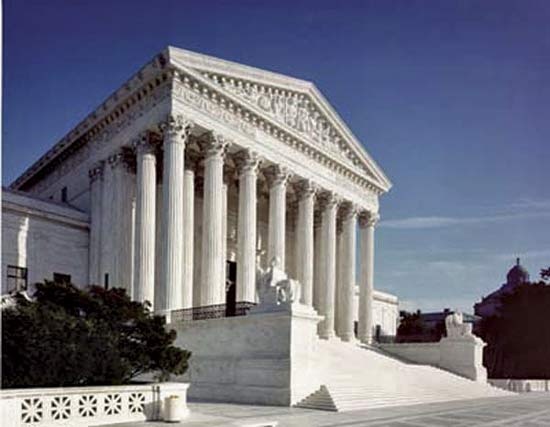
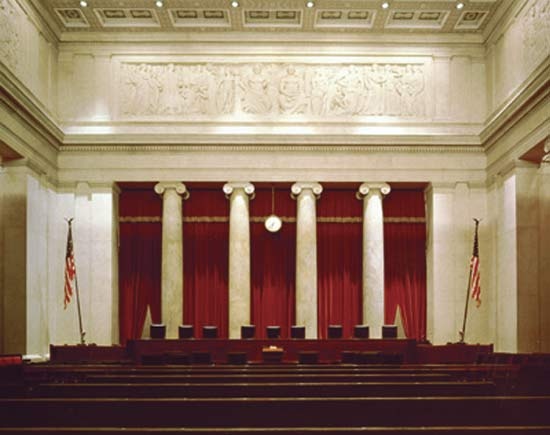
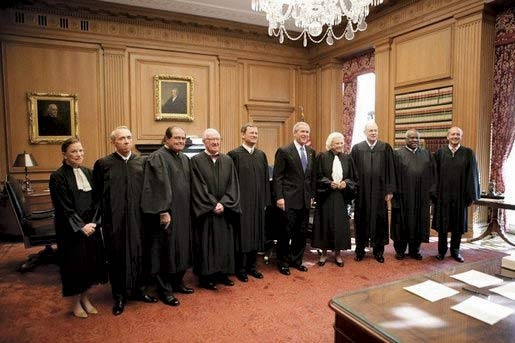 Supreme Court justices, U.S.final court of appeal and final expositor of the Constitution of the United States (Constitution of the United States of America). Within the framework of litigation, the Supreme Court marks the boundaries of authority between state and nation, state and state, and government and citizen. (For a list of justices of the U.S. Supreme Court, see table (Supreme Court justices, U.S.).)
Supreme Court justices, U.S.final court of appeal and final expositor of the Constitution of the United States (Constitution of the United States of America). Within the framework of litigation, the Supreme Court marks the boundaries of authority between state and nation, state and state, and government and citizen. (For a list of justices of the U.S. Supreme Court, see table (Supreme Court justices, U.S.).)Scope and jurisdiction
 The Supreme Court was created by the Constitutional Convention of 1787 as the head of a federal court system, though it was not formally established until Congress passed the Judiciary Act in 1789. Although the Constitution (Constitution of the United States of America) outlined the powers, structure, and functions of the legislative and executive branches of government in some detail, it did not do the same for the judicial branch, leaving much of that responsibility to Congress and stipulating only that judicial power be “vested in one supreme Court, and in such inferior Courts as the Congress may from time to time ordain and establish.” As the country's court of last resort, the Supreme Court is an appellate body, vested with the authority to act in cases arising under the Constitution, laws, or treaties of the United States; in controversies to which the United States is a party; in disputes between states or between citizens of different states; and in cases of admiralty and maritime jurisdiction. In suits affecting ambassadors, other public ministers, and consuls and in cases in which states are a party, the Supreme Court has original jurisdiction—i.e., it serves as a trial court. Relatively few cases reach the court through its original jurisdiction, however; instead, the vast majority of the court's business and nearly all of its most influential decisions derive from its appellate jurisdiction.
The Supreme Court was created by the Constitutional Convention of 1787 as the head of a federal court system, though it was not formally established until Congress passed the Judiciary Act in 1789. Although the Constitution (Constitution of the United States of America) outlined the powers, structure, and functions of the legislative and executive branches of government in some detail, it did not do the same for the judicial branch, leaving much of that responsibility to Congress and stipulating only that judicial power be “vested in one supreme Court, and in such inferior Courts as the Congress may from time to time ordain and establish.” As the country's court of last resort, the Supreme Court is an appellate body, vested with the authority to act in cases arising under the Constitution, laws, or treaties of the United States; in controversies to which the United States is a party; in disputes between states or between citizens of different states; and in cases of admiralty and maritime jurisdiction. In suits affecting ambassadors, other public ministers, and consuls and in cases in which states are a party, the Supreme Court has original jurisdiction—i.e., it serves as a trial court. Relatively few cases reach the court through its original jurisdiction, however; instead, the vast majority of the court's business and nearly all of its most influential decisions derive from its appellate jurisdiction.Size, membership, and organization

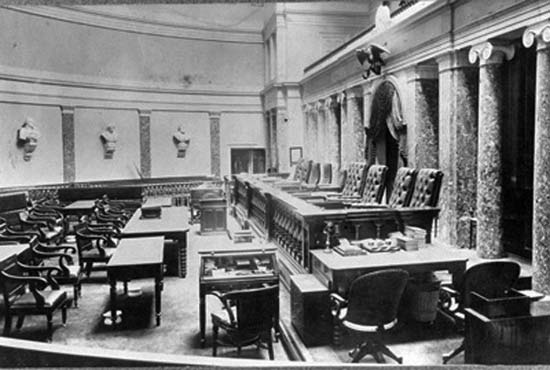 The organization of the federal judicial system, including the size of the Supreme Court, is established by Congress (Congress of the United States). From 1789 to 1807 the court comprised six justices. In 1807 a 7th justice was added, followed by an 8th and a 9th in 1837 and a 10th in 1863. Since 1869 the number of justices has been set at nine. The size of the court has sometimes been subject to political manipulation; for example, in the 1860s Congress reduced the number of justices to eight to ensure that President Andrew Johnson (Johnson, Andrew), whom the House of Representatives had impeached and the Senate only narrowly acquitted, could not appoint a new justice to the court; and in the 1930s President Franklin D. Roosevelt (Roosevelt, Franklin D.) asked Congress to consider legislation (which it subsequently rejected) that would have allowed the president to appoint an additional justice for each member of the court aged 70 years or older who refused to retire.
The organization of the federal judicial system, including the size of the Supreme Court, is established by Congress (Congress of the United States). From 1789 to 1807 the court comprised six justices. In 1807 a 7th justice was added, followed by an 8th and a 9th in 1837 and a 10th in 1863. Since 1869 the number of justices has been set at nine. The size of the court has sometimes been subject to political manipulation; for example, in the 1860s Congress reduced the number of justices to eight to ensure that President Andrew Johnson (Johnson, Andrew), whom the House of Representatives had impeached and the Senate only narrowly acquitted, could not appoint a new justice to the court; and in the 1930s President Franklin D. Roosevelt (Roosevelt, Franklin D.) asked Congress to consider legislation (which it subsequently rejected) that would have allowed the president to appoint an additional justice for each member of the court aged 70 years or older who refused to retire.According to the Constitution, appointments to the Supreme Court and to the lower federal courts are made by the president with the advice and consent of the Senate, though presidents have rarely consulted the Senate before making a nomination. The Senate Judiciary Committee ordinarily conducts hearings on nominations to the Supreme Court, and a simple majority of the full Senate is required for confirmation. When the position of chief justice is vacant, the president may appoint a chief justice from outside the court or elevate an associate justice to the position. In either case a simple majority of the Senate must approve the appointment. Members of the Supreme Court are appointed for life terms, though they may be expelled if they are impeached by the House of Representatives and convicted in the Senate. Only one justice has been impeached, Samuel Chase (Chase, Samuel), who was acquitted in 1805. In 1969 Abe Fortas (Fortas, Abe) resigned under threat of impeachment for alleged financial improprieties unrelated to his duties on the court.
The federal judicial system originally comprised only trial courts of original jurisdiction and the Supreme Court. As the country grew in size, and in the absence of intermediate appellate courts, the volume of cases awaiting review increased, and fidelity to Supreme Court precedents varied significantly among the lower courts. To remedy this problem, Congress passed the Circuit Court of Appeals Act (1891), which established nine intermediate courts with final authority over appeals from federal district courts, except when the case in question was of exceptional public importance. The Judiciary Act of 1925 (popularly known as the Judges' Bill), which was sponsored by the court itself, carried the reforms farther, greatly limiting obligatory jurisdiction (which required the Supreme Court to review a case) and expanding the classes of cases that the court could accept at its own discretion through the issue of a writ of certiorari. Further changes were enacted in 1988, when Congress passed legislation that required the Supreme Court to hear appeals of cases involving legislative reapportionment and federal civil rights and antitrust laws. Currently, there are 12 geographic judicial circuits and a court of appeals for the federal circuit, located in Washington, D.C. Roughly 98 percent of federal cases end with a decision by one of the lower appellate courts.
Procedures and power
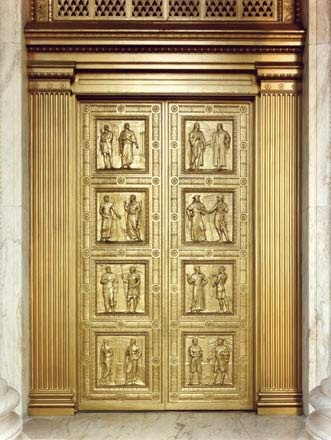 The Supreme Court, which now enjoys almost exclusive discretion in determining its caseload, hears about 100 cases per term, which begins by statute (set in 1917) on the first Monday in October and typically ends in late June (though from 1873 to 1917 the court began its term on the second Monday in October). Each year the court receives some 7,000 certiorari requests. The number of these requests has increased some fivefold since World War II—a reflection of the country's population growth, a progressively more litigious legal culture, and a surge in the demands placed by citizens on government. As the number of certiorari requests has increased, the number of cases decided by the Supreme Court has declined since the 1950s and '60s, when civil rights cases dominanted the docket, as the justices have opted to hear fewer cases per salient issue area.
The Supreme Court, which now enjoys almost exclusive discretion in determining its caseload, hears about 100 cases per term, which begins by statute (set in 1917) on the first Monday in October and typically ends in late June (though from 1873 to 1917 the court began its term on the second Monday in October). Each year the court receives some 7,000 certiorari requests. The number of these requests has increased some fivefold since World War II—a reflection of the country's population growth, a progressively more litigious legal culture, and a surge in the demands placed by citizens on government. As the number of certiorari requests has increased, the number of cases decided by the Supreme Court has declined since the 1950s and '60s, when civil rights cases dominanted the docket, as the justices have opted to hear fewer cases per salient issue area.All certiorari requests are circulated among the justices. The chief justice leads the court in developing a “discuss list” of potential cases, though the associate justices may request that additional cases be placed on the list. By the so-called “Rule of Four,” apparently developed in the late 19th century, the decision to grant certiorari requires the assent of at least four justices. Once the decision to hear a case has been made, lower-court records and briefs are delivered to the court and oral arguments are scheduled. Interested third parties also may submit their opinions to the court by filing an amicus curiae (Latin: “friend of the court”) brief. With rare exceptions the petitioners and respondents are each allotted 30 minutes of time to present their arguments to the court. The justices hear neither witnesses nor evidence. Each side in the case attempts to persuade the justices that the Constitution should be interpreted in a manner that supports its point of view.
The decision-making process involves two major judgments. First, in a vote that is usually kept secret, the justices decide the merits of the case; then they issue the official written decision of the court. The first judgment determines who will write the official decision. By tradition, if the chief justice is in the majority, he selects which justice (including himself) will author the court's verdict. If he is in the minority, the longest-serving member of the majority makes the decision-writing appointment. Since the era of John Marshall (Marshall, John), chief justice from 1801 to 1835, it has been common practice for the court to issue formal opinions to justify its decisions, though the Constitution does not require it to do so. Drafts of all opinions circulate among the justices, and all justices may concur with or dissent from any decision, in full or in part. The final decision effectively represents the supreme law of the land and is expected to be used as controlling constitutional doctrine by lower courts.
The Supreme Court exercises the power of judicial review, whereby it can declare acts of Congress or the state legislatures unconstitutional. Executive, administrative, and judicial actions also are subject to review by the court. The doctrine of judicial review is not mentioned explicitly in the Constitution; instead, it was articulated by Marshall in Madison (Marbury v. Madison) (1803), in which the court struck down part of the Judiciary Act of 1789. Although since the late 19th century the vast majority of legal scholars have accepted judicial review as a proper power of the Supreme Court, critics have charged that the framers did not intend for the court to exercise such power, which allows it to act in effect as a legislative body.
Historical trends
Any assessment of the unifying forces in American society must ascribe a significant role to the Supreme Court. In its institutional infancy, the court necessarily addressed structural and functional questions involving inter alia federalism, express and implied powers, checks and balances, and the separation of powers (powers, separation of). During the mid- to late 19th century, the court employed the Constitution's commerce clause (Article I Section 8) to nullify state laws of taxation or regulation that discriminated against or unduly burdened interstate commerce. The clause subsequently was used to uphold the power of Congress to regulate vast sectors of the economy.
Whereas the commerce clause has been the chief doctrinal source of power over the economy, the due-process (due process) clause of the Fifth Amendment and the equal-protection (equal protection) clause of the Fourteenth Amendment have been the principal sources of protection of persons and corporations against arbitrary or repressive acts of government. These clauses were used at first to protect property rights, but in the 1920s they began to be applied to civil liberties, particularly in the extension of Bill of Rights guarantees to state actions. By the middle of the century, the equal-protection clause, which had been designed to protect the rights of emancipated slaves, was being used to strike down laws that were racially discriminatory, and all rights guaranteed by the First Amendment had been incorporated (and thusly made applicable to the states) through the due-process clause of the Fourteenth Amendment. By the end of the 20th century, the court found itself addressing issues that had previously been considered off-limits according to the political question doctrine, which it had invoked to avoid entering into questions that it thought were best decided by legislatures (e.g., prison administration, the operation of districting systems, and even, arguably, the 2000 presidential election). While broadening the concept of justiciable disputes, the court also sought to limit congressional power to control the affairs of the states. In a variety of cases concerning issues such as state immunity from lawsuits, commerce, and criminal procedure, a states' rights approach was adopted by the court's conservative majority.
The opinions of the Supreme Court, including the dissenting opinions of individual justices, often have been considered epitomes of legal reasoning. Through these opinions, the court serves to clarify, refine, and test the philosophical ideals written into the Constitution and to translate them into working principles for a federal union under law. Beyond its specific contributions, this symbolic and pragmatic function may be regarded as the most significant role of the court.
- Freya Stark
- Freyberg, Bernard Cyril Freyberg, 1st Baron
- Freycinet, Charles-Louis de Saulces de
- Freycinet, Louis-Claude de Saulces de
- Freycinet Peninsula
- Freyja
- Freyr
- Freyre, Gilberto de Mello
- Freyssinet, Eugène
- Freytag, Gustav
- Frey-Wyssling, Albert F.
- Fria
- friar
- Friar Lands Question
- Fribourg
- fricative
- Frick Collection
- Frick, Ford
- Frick, Henry Clay
- Frick, Wilhelm
- friction
- Victoria Draves
- Victoria Falls
- Victoria, flag of
- Victoria, Guadalupe